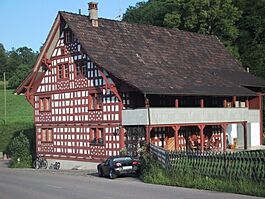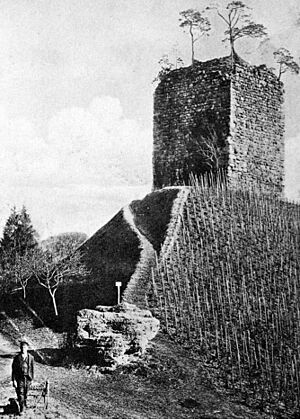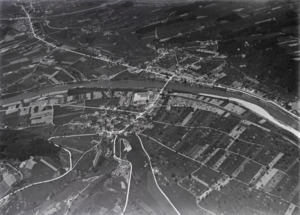Kradolf-Schönenberg facts for kids
Quick facts for kids
Kradolf-Schönenberg
|
||
|---|---|---|

House in Buhwil village
|
||
|
||
| Country | Switzerland | |
| Canton | Thurgau | |
| District | Weinfelden | |
| Area | ||
| • Total | 10.95 km2 (4.23 sq mi) | |
| Elevation | 455 m (1,493 ft) | |
| Population
(Dec 2020 )
|
||
| • Total | 3,677 | |
| • Density | 335.80/km2 (869.7/sq mi) | |
| Postal code |
9214, 9215
|
|
| Localities | Buhwil, Kradolf, Neukirch an der Thur, Ober Buhwil, Schönenberg an der Thur, Unterau, Unter Buhwil | |
| Surrounded by | Bischofszell, Bürglen, Hohentannen, Niederhelfenschwil (SG), Schönholzerswilen, Sulgen, Wuppenau | |
Kradolf-Schönenberg is a town, also called a municipality, in the Thurgau area (or canton) of Switzerland. It is part of the Weinfelden District.
This municipality was formed in 1996. It was created by joining four smaller villages: Buhwil, Kradolf, Neukirch an der Thur, and Schönenberg an der Thur.
Contents
History of Kradolf-Schönenberg
The different parts of Kradolf-Schönenberg have long histories. Kradolf was first written about in the year 883. Back then, it was called Chreinthorf. Later, in 1276, its name changed to Kraedorf.
Schönenberg an der Thur also appeared in records in 883. It was known as Thuruftisthorf. By 1359, it was called Schönnenberg.
Neukirch an der Thur was first mentioned in 1291 as Eliswil. A few years later, in 1296, it was called Sêliswille. This name stayed until the Protestant Reformation. After 1520, it became known as Nüwenkilchen.
Buhwil is the oldest village mentioned. It appeared in records in 838 as Puabinwilare.
Geography of Kradolf-Schönenberg
Kradolf-Schönenberg covers an area of about 10.96 square kilometers (4.23 square miles). This information is from 2009.
Most of the land is used for farming. About 61.6% of the area is farmland. Forests cover a good portion too, about 23.7% of the land.
About 12% of the municipality is built up with buildings and roads. A small part, 2.3%, includes rivers or lakes. Very little land, 0.2%, is not used for anything.
The municipality is in the Weinfelden District. It is made up of several villages that stretch out in a line. These are Kradolf, Buhwil, Neukirch an der Thur, and Schönenberg an der Thur.
Population and People
Kradolf-Schönenberg has a population of 3,215 people. This number is from December 2007.
In 2008, about 19.3% of the people living here were from other countries. Over ten years (1997–2007), the population grew by about 0.7%.
Most people in Kradolf-Schönenberg speak German. About 87.6% of the population spoke German in 2000. The next most common language was Albanian (4.8%), followed by Italian (1.9%).
In 2008, there were slightly more men than women. About 51.4% of the population was male, and 48.6% was female.
The population is made up of different age groups. In 2009, about 9.1% of the people were children aged 0-9. Teenagers (10-19 years old) made up 14.7% of the population. Adults aged 20-59 made up a large part of the population. Older adults (60 and above) made up about 16.5%.
The historical population of the different villages that form Kradolf-Schönenberg is shown below:
| Year | Population Kradolf |
Population Schönenberg an der Thur |
Population Neukirch an der Thur |
Population Buhwil |
|---|---|---|---|---|
| 1831 | 190 | |||
| 1850 | 147 | 2,546 | 320 | |
| 1870–1880 | 228 | 254 | ||
| 1900–1910 | 649 | 820 | 1,921 | 283 |
| 1920 | 1,064 | |||
| 1950–1960 | 983 | 813 | 1,879 | 282 |
| 1990–1995 | 1,183 | 1,249 | 1,997 | 287 |
| Year | Population | |||
| 2000 | 3,062 | |||
Economy and Jobs
In 2007, the unemployment rate in Kradolf-Schönenberg was low, at 1.73%. This means most people who wanted to work had jobs.
In 2005, many people worked in different types of jobs:
- Primary sector: 142 people worked in farming or related businesses. There were 52 such businesses.
- Secondary sector: 461 people worked in factories or construction. There were 41 businesses in this area.
- Tertiary sector: 431 people worked in services, like shops, offices, or schools. There were 89 businesses in this sector.
In 2000, 2,117 people who lived in Kradolf-Schönenberg had jobs. About 48.3% of these residents worked outside the municipality. However, 424 people came into Kradolf-Schönenberg for work.
Most people used private cars to get to work (51.1%). About 8.4% used public transportation.
Religion in Kradolf-Schönenberg
Based on the 2000 census, people in Kradolf-Schönenberg follow different religions:
- About 28% were Roman Catholic.
- About 42.3% belonged to the Swiss Reformed Church (a type of Protestant church).
- About 12.05% of the population were Islamic.
- Some people belonged to other Christian churches (6.07%) or the Orthodox Church (1.21%).
- About 6.4% of the population did not belong to any church.
Education and Schools
Switzerland has a good education system. In Kradolf-Schönenberg, many adults (aged 25-64) have completed higher education. This means they went to a university or a special college after high school.
The Schönenberg-Kradolf area has its own primary school district. In the 2008/2009 school year, there were 200 students.
- Kindergarten: There were 42 children in kindergarten. The average class size was 21 students. About 14.3% of these children were not Swiss citizens. Also, 11.9% did not speak German as their first language.
- Primary School: There were 65 children in the lower primary grades and 93 in the upper primary grades. The average class size for primary school was 21 students. In the lower primary, 23.1% of students were not Swiss citizens, and 24.6% did not speak German natively. In the upper primary, 28% were not Swiss citizens, and 24.7% did not speak German natively.
See also
 In Spanish: Kradolf-Schönenberg para niños
In Spanish: Kradolf-Schönenberg para niños








